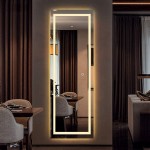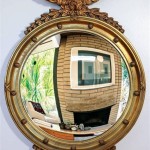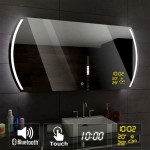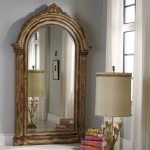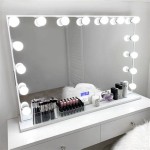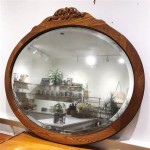How To Hang a Bathroom Mirror
Hanging a bathroom mirror correctly is crucial for both aesthetic appeal and safety. A poorly hung mirror can be a hazard, while a properly installed one enhances the bathroom's design and functionality. This article provides a comprehensive guide to hanging a bathroom mirror securely and efficiently.
1. Assess the Wall and Choose the Right Hanging Method
Before starting, evaluate the bathroom wall's material. Drywall is common, but some bathrooms might have tile or plaster walls. The wall material determines the appropriate hanging method and hardware. For heavier mirrors, especially on drywall, consider using wall anchors to provide extra support and prevent the mirror from pulling out of the wall.
Consider the mirror's weight and size. Lighter, smaller mirrors can often be hung with adhesive strips designed specifically for mirrors. These are a good option for renters or those who want to avoid drilling. Medium to large mirrors, particularly those with frames, usually require traditional hanging hardware like D-rings, wire, or J-clips.
2. Gather the Necessary Tools and Materials
Having all the necessary tools and materials readily available streamlines the hanging process. The required items may vary depending on the chosen hanging method, but commonly include a measuring tape, level, pencil, drill (if necessary), screwdriver, appropriate screws, wall anchors (if necessary), and the chosen hanging hardware (D-rings, wire, J-clips, or adhesive strips).
For added safety, consider wearing safety glasses while drilling or hammering.
3. Locate and Mark the Desired Mirror Position
Determining the mirror's placement requires careful consideration of the bathroom layout. Account for the height of the vanity, lighting fixtures, and the average eye level of those using the mirror. Use a measuring tape to determine the center point of the vanity and mark this point on the wall. This serves as a reference for positioning the mirror.
Once the center point is established, measure the mirror's height and width. Use these measurements to mark the desired top and bottom points of the mirror on the wall, ensuring alignment with the vanity's center point. A level ensures the markings are perfectly horizontal.
4. Install the Hanging Hardware on the Mirror
If using D-rings or wire, attach them securely to the back of the mirror frame according to the manufacturer's instructions. Ensure the D-rings are evenly spaced and level. If using wire, create a taut wire across the back of the mirror, securely fastened to the D-rings. For J-clips, attach them to the back of the mirror according to the manufacturer's instructions. The placement of these clips depends on the specific type of J-clip and the mirror's frame.
If using adhesive strips, carefully follow the manufacturer's instructions for application. Usually, this involves cleaning the back of the mirror and the wall surface before firmly pressing the strips onto both surfaces. Ensure the strips are evenly distributed to support the mirror's weight.
5. Secure the Mirror to the Wall
For traditional hanging hardware, measure the distance between the hanging points on the back of the mirror (D-rings, wire, or J-clips). Transfer these measurements to the wall markings, creating corresponding points where the screws or hooks will be installed. If using wall anchors, pre-drill holes and insert the anchors before inserting the screws. Ensure the screws are driven in straight and securely to support the mirror’s weight. Carefully hang the mirror on the installed hardware.
For adhesive strips, carefully align the mirror with the marked position on the wall and firmly press the mirror against the wall for the duration specified by the adhesive manufacturer. This activates the adhesive bond and secures the mirror in place.
6. Verify the Mirror's Position and Stability
Once the mirror is hung, use a level to verify its horizontal alignment. Gently press on different areas of the mirror to check for stability. If the mirror feels loose or wobbly, re-evaluate the installation process and ensure all hardware is securely fastened. If necessary, reinforce the hanging points with additional screws or stronger wall anchors.
After verifying stability, clean the mirror surface to remove any fingerprints or smudges acquired during the installation process. This ensures the mirror is ready for use and enhances its reflective qualities.
7. Applying Sealant (Optional)
For added protection against moisture and to create a more finished look, consider applying a thin bead of sealant around the perimeter where the mirror meets the wall. Choose a sealant specifically designed for bathrooms that is waterproof and mildew-resistant. Allow the sealant to cure completely according to the manufacturer's instructions before exposing it to moisture.

Tutorial How To Hang A Bathroom Mirror The Diy Playbook

How To Install A Mirror Without Frame Merrypad

How To Hang A Wash Basin Mirror Step By Guide Accent

Tutorial How To Hang A Bathroom Mirror The Diy Playbook

How To Hang A Mirror Zn Construction

Guide To Hanging Bathroom Vanity Lighting And Mirrors Liven Design

How To Hang A Mirror Glass Genius

How To Hang A Bathroom Mirror Over Tile Wainscoting Mimzy Company

How To Hang A Mirror On Window 12 Bright Beautiful Examples Designed

Suspended Mirror Bath

